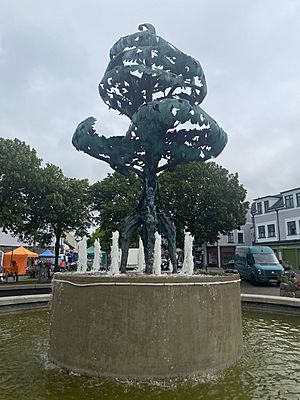Battle of Carlow facts for kids
Quick facts for kids Battle of Carlow |
|||||||
|---|---|---|---|---|---|---|---|
| Part of the Irish Rebellion | |||||||
 Liberty Tree in Carlow, a memorial to the Battle |
|||||||
|
|||||||
| Belligerents | |||||||
| Commanders and leaders | |||||||
| Thomas Mahon | Heydon, Brennan, Redmond, Nolan | ||||||
| Strength | |||||||
| c. 500 | c. 1,200 | ||||||
| Casualties and losses | |||||||
| None reported | c.600 and 400 civilians | ||||||
The Battle of Carlow happened in Carlow town, Ireland, on May 25, 1798. This battle was part of the Irish Rebellion of 1798, which had started just the day before. Rebels from Carlow joined the fight to support the rebellion.
The main group leading the rebels in Carlow was called the Society of United Irishmen. Their leader was a young man named Mick Heydon. He took over after the previous leader, Peter Ivers, was arrested. On the night of May 24, the rebels gathered. At dawn, about 1,200 of them marched towards Carlow town. They faced no resistance on their way.
Contents
The Rebel Plan
The rebels planned to attack Carlow town from four different directions at the same time. They would move through the four main streets.
- From Bennekerry and Tinryland, they would enter Tullow Street.
- From Ballybar and Garryhundon, they would march into Burrin Street.
- From Laois, they would cross Graiguecullen bridge and the River Barrow.
- From Palatine and Maganey, they would come through Dublin Street.
All the rebel groups aimed to meet in a central spot called Potato Market.
Government Prepares an Ambush
What the rebels did not know was that Colonel Mahon, a military leader, was ready for them. He had his soldiers in the barracks and around the town on high alert. He knew about the rebels' every move.
A strong group of soldiers was placed in the court house. This building is now known as the Deighton Hall. Another group, with two small cannons, waited on the bridge. On Graigue bridge, there was a guard of yeomen, who were local soldiers.
In Dublin Street, armed loyalists were in strong houses. But they had little military support there. This was because the attack from that side was expected to be weak. Tullow Street was left open and seemed unprotected. This was meant to look like the easiest way in. The trap was set for the rebels.
The Battle Unfolds
When the rebels entered Carlow town, many people joined them. These included local Catholic residents and others who had secretly arrived. About 200 people broke away and marched through Tullow Street. But when they reached Potato Market, everything changed.
The soldiers, who were ready, had set up a deadly ambush. They had men hidden at every window and on every rooftop. As the rebels thought they had won easily, the hidden soldiers opened fire. They shot many times into the large group of rebels.
The rebels were completely surprised. They were poorly armed and quickly broke apart. They tried to run away, but they ran into another army ambush. The rebels who survived tried to escape by going through nearby houses. But the soldiers set these houses on fire. This caused the deaths of about 200 people living in those homes.
Laois Rebels' Actions
Meanwhile, rebels from County Laois were on their way to help the Carlow rebels. They heard confusing news about the battle. When they learned what happened to their friends, they decided it was too late to help. Their leaders were men named Redmond and Brennan.
They changed their plans and went to Ballickmoyler instead. This place is a few miles outside Carlow, in County Laois. There, they set fire to many houses belonging to loyalists. They also attacked the home of John Whitty, a Protestant clergyman. Twenty-one rebels were killed in this fight. But despite their losses, they eventually defeated the loyalist residents.
Aftermath of the Battle
It is believed that about 500 rebels and civilians died in the streets of Carlow town. The military reported no losses. Over the next ten days, another 150 people were captured and punished. A local man, known as "Paddy the Pointer," reportedly helped the military. He rode around town and pointed out rebels who had escaped.
A memorial stands in Graiguecullen today. It marks a "Croppy Hole," which was a mass grave. The remains of many people who died that day were thrown into this hole.

